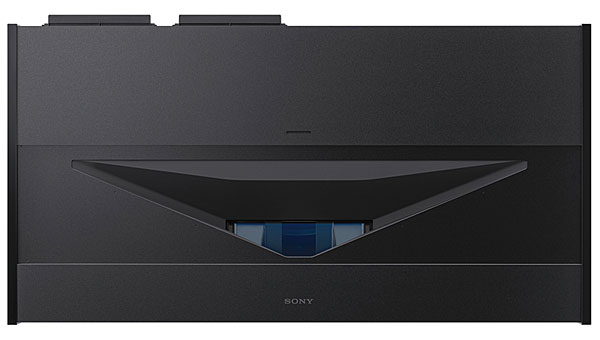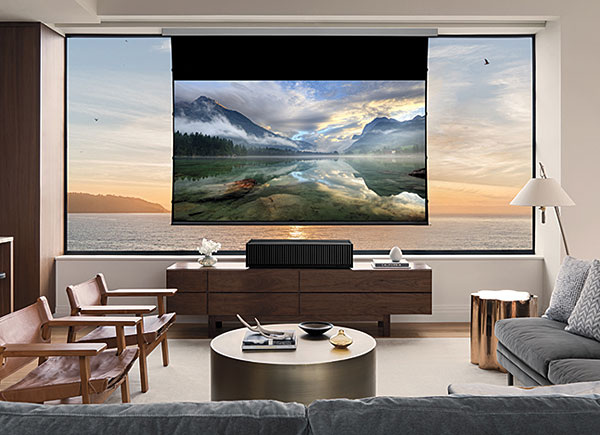Sony VPL-VZ1000ES SXRD 4K Ultra-Short-Throw Projector Review Page 2
2D Performance
Sony’s ultra-short-throw projector is not only designed to look like furniture when sitting out in your living space, it’s designed to present a bright image with good contrast in a typical, well-lit room. Achieving the latter depends on pairing the projector with the right screen, which is why Sony recommends using an ambient light rejecting (ALR) model such as the aforementioned Screen Innovations Short Throw (ST) screen that I used for this test. ALR screens manage to deliver bright pictures in high ambient light environments by incorporating optical elements that reflect just the light coming from a specific angle. In the case of the Screen Innovations ST, that means that only the light projected upward at the screen from below gets beamed back, while light coming from other sources is effectively absorbed.
 Streaming the film Dr. Strange from Netflix with overhead lights in my room going full blast, the picture looked bright and had solid contrast. In a scene where the Ancient One leads Strange on an astral voyage to the top of Mount Everest, for example, sunlight reflected from the snow-covered mountains looked appropriately intense. And in a later scene where the humbled doctor borrows his first book from the library at Kamar-taj, shadows had good depth, and shadow details like the rows of books in the gloomy space could be easily seen. The picture didn’t match the level of pop I’m used to getting with flat-panel TVs—or from the best regular projector setups using a matte white screen in a dark room, for that matter— but it did exceed my expectations, especially given the huge 92-inch screen size I tested.
Streaming the film Dr. Strange from Netflix with overhead lights in my room going full blast, the picture looked bright and had solid contrast. In a scene where the Ancient One leads Strange on an astral voyage to the top of Mount Everest, for example, sunlight reflected from the snow-covered mountains looked appropriately intense. And in a later scene where the humbled doctor borrows his first book from the library at Kamar-taj, shadows had good depth, and shadow details like the rows of books in the gloomy space could be easily seen. The picture didn’t match the level of pop I’m used to getting with flat-panel TVs—or from the best regular projector setups using a matte white screen in a dark room, for that matter— but it did exceed my expectations, especially given the huge 92-inch screen size I tested.
While the VZ1000ES can deliver a bright enough standard dynamic range picture to look good during daytime viewing, like many HDR-enabled projectors, its light output capability is somewhat limited when it comes to viewing HDR content. Even so, when I dimmed the lights and compared Blu-ray and Ultra HD versions of the same movie, the image did look more dynamic when viewing the Ultra HD disc. For example, watching a scene that takes place in a seedy motel parking lot in Logan (the best Marvel comic character-driven movie I’ve seen in years), the neon signs and streetlights had a distinctly punchier glow in the HDRenhanced UHD version. Colors in this scene also looked vivid, though given the Sony’s somewhat limited P3 color space coverage (I measured 90.4 percent), it’s possible the Sony wasn’t delivering the full spectrum of hues contained on the disc.
The Logan disc set I own contains color and black and white “noir” versions of the film on both regular and Ultra HD Blu-ray. Interestingly, the movie’s HDR effects were even more pronounced when viewed in black and white: Blacks looked deeper, and highlights in the parking lot scene and others popped off the screen in a striking manner. But watching black and white movies with the VZ1000ES also had the effect of revealing its below-average picture uniformity: Gray tones at the edges of the screen had a distinctly cooler tint compared with those at the center. Switching back to the color version of Logan, I didn’t notice the uniformity issue nearly as much as with the black and white disc, but it could still be seen.
Investigating further with test patterns, I measured about a 1,600K color shift toward blue from center to the outer edges of the image that I isolated to the projector by temporarily bringing in my reference matte white screen. Light output also dropped off somewhat from center to edge, by as much as 6 foot-lamberts from my calibrated 24.6 ft-L peak-white measurement. However, these effects were much less visible when the projector was in its Bright Cinema and Bright TV modes and may not carry the same weight when the projector is set up for viewing in well-lit rooms. Another consolation for old black and white movie fans: Most old movies shot in black and white used the squarish 1.33 aspect ratio, so the left and right edges of the screen will be filled with vertical black bars.

A second VZ1000ES Sony sent me revealed similar uniformity issues, though they weren’t as pronounced as on the first review sample. Maximum color shift was limited to around 1,500 degrees, and light drop-off maxed out at 5.6 ft-L. Similar to the first projector, I noted the impact mostly when watching black and white movies like the noir version of Logan, or an all-white image of the northern wall in the Game of Thrones season 7 premiere.
3D Performance
It might be fading from panel TVs, but 3D is still very much a feature in the projection world. Each picture preset on the VZ1000ES can be independently adjusted for 3D viewing, and the projector also supports 3D upconversion of 2D sources. Watching Hugo, one of my old standard 3D test discs, the film’s 3D depth effects looked very good, though I did note ghosting in some shots. Checking another 3D disc, Passengers, I didn’t see any ghosting, and the shots that displayed good 3D depth effects, such as the ones of the ship zipping through space, looked solid and had good contrast on the big screen.

Conclusion
To put Sony’s VPL-VZ1000ES in perspective, it’s useful to compare it with the company’s previous 4K ultra-short-throw model, the LSPX-W1S. As noted earlier, that projector was significantly larger and heavier than the VZ1000ES, and at $50,000, it cost twice as much. The company has clearly made strides with its new ultra-short throw, which offers features that its predecessor lacked, including compatibility with HDR sources and powered lens shift and zoom for more flexible setup.
Critically, the VPL-VZ1000ES also fulfills its promise as a big-screen alternative to a flat-panel TV for casual, everyday viewing: The big, bright, crisp Ultra HD picture put out by the Sony projector and Screen Innovations Short Throw screen combination is easy to love, especially when viewed during daylight hours in a well-lit room. But it won’t be the best choice for all viewers. In particular, the picture uniformity issue I noted is the sort of thing that can get under the skin of a fussy video perfectionist. If that label applies to you, you’ll probably be better off using a traditional home theater setup in a dark room with a ceiling-mounted projector. However, if you spend most of your time watching sports and Netflix comedy specials and are looking for an easy way to get a 100-inch-plus image in your living room at a comparatively affordable price to a like-size flatpanel TV, you’ll find plenty to get excited about with Sony’s new ultra-short-throw projector.























































